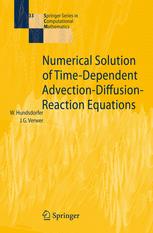

Most ebook files are in PDF format, so you can easily read them using various software such as Foxit Reader or directly on the Google Chrome browser.
Some ebook files are released by publishers in other formats such as .awz, .mobi, .epub, .fb2, etc. You may need to install specific software to read these formats on mobile/PC, such as Calibre.
Please read the tutorial at this link: https://ebookbell.com/faq
We offer FREE conversion to the popular formats you request; however, this may take some time. Therefore, right after payment, please email us, and we will try to provide the service as quickly as possible.
For some exceptional file formats or broken links (if any), please refrain from opening any disputes. Instead, email us first, and we will try to assist within a maximum of 6 hours.
EbookBell Team

4.3
58 reviewsThis book describes numerical methods for partial differential equations (PDEs) coupling advection, diffusion and reaction terms, encompassing methods for hyperbolic, parabolic and stiff and nonstiff ordinary differential equations (ODEs). The emphasis lies on time-dependent transport-chemistry problems, describing e.g. the evolution of concentrations in environmental and biological applications. Along with the common topics of stability and convergence, much attention is paid on how to prevent spurious, negative concentrations and oscillations, both in space and time. Many of the theoretical aspects are illustrated by numerical experiments on models from biology, chemistry and physics. A unified approach is followed by emphasizing the method of lines or semi-discretization. In this regard this book differs substantially from more specialized textbooks which deal exclusively with either PDEs or ODEs. This book treats integration methods suitable for both classes of problems and thus is of interest to PDE researchers unfamiliar with advanced numerical ODE methods, as well as to ODE researchers unaware of the vast amount of interesting results on numerical PDEs. The first chapter provides a self-contained introduction to the field and can be used for an undergraduate course on the numerical solution of PDEs. The remaining four chapters are more specialized and of interest to researchers, practitioners and graduate students from numerical mathematics, scientific computing, computational physics and other computational sciences.